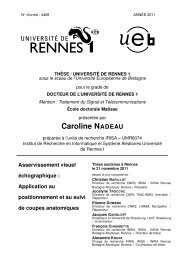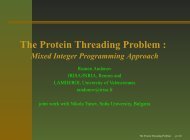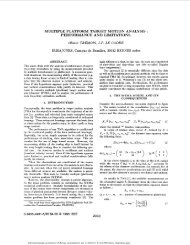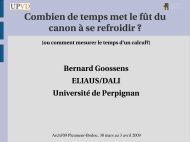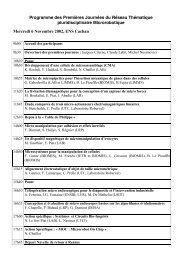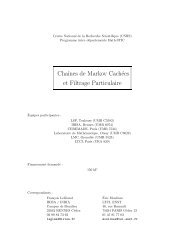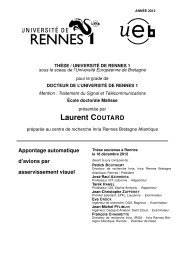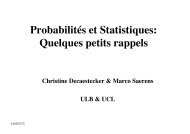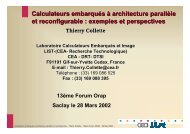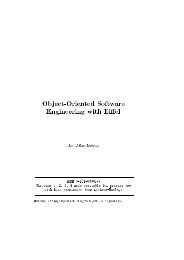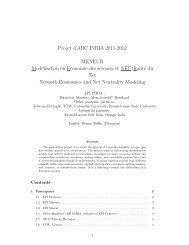Atelier Visualisation et extraction de connaissances - Irisa
Atelier Visualisation et extraction de connaissances - Irisa
Atelier Visualisation et extraction de connaissances - Irisa
You also want an ePaper? Increase the reach of your titles
YUMPU automatically turns print PDFs into web optimized ePapers that Google loves.
Correspon<strong>de</strong>nce Analysis for<br />
Exploration of Telecommunication Data<br />
Nguyen-Khang Pham*, Hung-Thang Pham**<br />
*Can Tho University<br />
1, Ly Tu Trong Stre<strong>et</strong>, Can Tho, Vi<strong>et</strong> Nam<br />
pnkhang@cit.ctu.edu.vn<br />
http://www.ctu.edu.vn<br />
**Can Tho – Hau Giang Telecommunications<br />
11A, Phan Dinh Phung Stre<strong>et</strong>, Can Tho, Vi<strong>et</strong> Nam<br />
thangph.cthg@vnpt.vn<br />
http://www.vnpt.vn<br />
Summary. We propose, in this paper, an interactive graphical tool, which allows<br />
us to analyze, visualize and extract knowledge from telecommunication<br />
data using Correspon<strong>de</strong>nce Analysis. Telecom companies have a very large<br />
volume and valuable data source on consumer information and call record d<strong>et</strong>ails<br />
(CRD’s). The CRD’s not only indicate when a service is used, but also<br />
said that it is used. How we can point out what customers need, and why they<br />
should use a certain service. CRD's also said customers who are unhappy, and<br />
customers who bring more profit than others. Therefore, challenges that telecom<br />
companies do face is to un<strong>de</strong>rstand the customer, to study their habits of<br />
using telecommunication services. Correspon<strong>de</strong>nce Analysis (CA) is originally<br />
for analysis of contingency tables. In or<strong>de</strong>r to adapt CA on telecommunication<br />
data, they are co<strong>de</strong>d in a form of contingency table crossing customers and<br />
telecommunication services. Applying successively CA on this table allow us<br />
to explore groups of customers who have the same habit of using telecommunications<br />
services. First, the results of the first CA are visualized. Then the<br />
user selects a group of customers and performs the second CA on the new contingency<br />
table. This procedure can continue until a “pure” group of customers<br />
is discovered. An application to the CRD’s database of Can Tho – Hau Giang<br />
Telecommunications shows the interest of our tool for extracting knowledge<br />
from telecommunication data.<br />
1 Introduction<br />
Nowadays, information has become a powerful resource of mo<strong>de</strong>rn business. More than<br />
ever, the business organization in the world have focused on <strong>de</strong>veloping information systems<br />
as a key source of creating comp<strong>et</strong>itive advantage and improve responsiveness to mark<strong>et</strong>.<br />
Not outsi<strong>de</strong> the telecommunications industry trend, telecom companies have very valuable<br />
data source that is a large volume of data on consumer information and calls record d<strong>et</strong>ail<br />
(CRD’s), every day millions of calls recor<strong>de</strong>d in exchanges with the first goal is to charge the<br />
customer and n<strong>et</strong>work management. The call records not only indicate when a service is<br />
used, but also said that service is used, how it can point out what clients need, and why cus-<br />
F.Poul<strong>et</strong>, B.Le Grand : 9e <strong>Atelier</strong> <strong>Visualisation</strong> <strong>et</strong> Extraction <strong>de</strong> Connaissances 13



